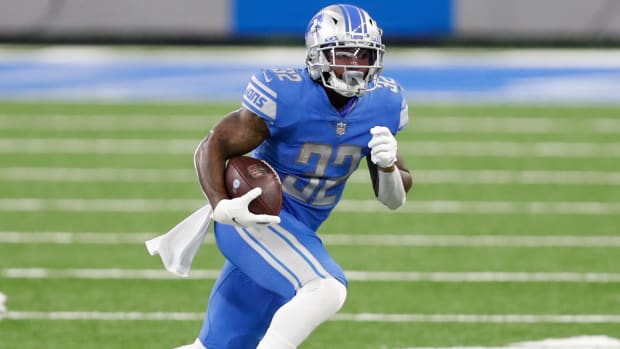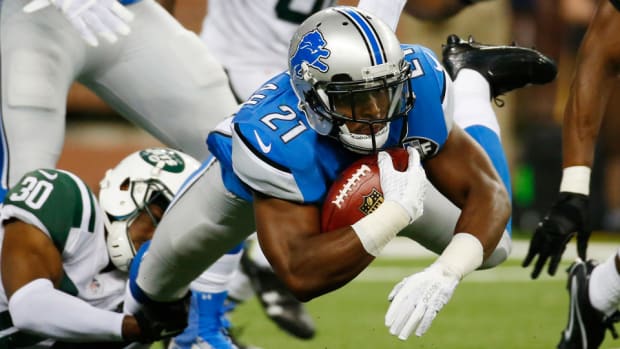SI Fantasy analyst Michael Fabiano explains why the only thing standing in the way of D'Andre Swift might be the Detroit Lions
The summer is here, meaning we're getting closer to the start of fantasy football drafts. Success in those drafts will come from landing terrific bargains in the middle to late rounds while avoiding players who could see their numbers decline compared to 2020. However, that latter exercise isn't easy, especially in the case of players who are among the elite at their position or are coming off breakout seasons in the stat sheets.
However, fantasy managers also need the 411 on second-year players who showed off some potential as rookies and have seen their stock rise as we enter their sophomore seasons. In 2021, there are several such players who fantasy fans will be drafting highly and leaning on to play prominent roles on their rosters. The question is, can we find some stats or trends that might help us separate the breakouts from the busts?
That leads me to this series, aptly named “The Fantasy Case Against…” where I’ll do my due diligence in looking at players who everyone in fantasy land seems to think is a sure bet to remain or become uber-productive after finding a high level of past success.
The Fantasy Case Against ...
- Justin Herbert
- Zach Wilson (Dynasty)
- Alvin Kamara
- D'Andre Swift
- David Montgomery
- Derrick Henry
- Michael Carter
- Saquon Barkley
- Julio Jones
- Justin Jefferson
- Kenny Golladay
Next up, let’s look into Lions running back and breakout candidate D’Andre Swift.
2020 Season
Swift finished this rookie campaign ranked 18th in fantasy points among running backs. That's rather good, considering he averaged a meager 12.3 touches per game. In fact, he averaged the third-fewest touches among the top 18 players at his position. Overall, Swift ranked fourth among rookie backs with nearly 190 points.
Did You Know?

Swift finished second in touches among Lions running backs last season behind Adrian Peterson (who is no longer on the roster). He finished with a 21.6 percent touch share, while A.D. finished at 22.7 percent. However, Swift averaged more points (12.3) a game than Peterson (10.5). Swift was also very productive when his touch totals increased.
In the five games where Swift saw at least 15 touches, he averaged 20.8 fantasy points. That includes three games where the former Georgia runner scored 22-plus points. It is those performances that have countless fantasy fans excited about his 2021 prospects.
Historical Trends
In the 22 years since Hall of Famer and fantasy football superstar Barry Sanders left the Detroit franchise, the team has drafted 19 running backs. Of those 19 runners, nine were taken in the first three rounds (two in Round 1, four in Round 2, three in Round 3).
The results have been, well, not good.
Let's focus on the most prominent selections at the position, starting with the 2000 NFL Draft and Reuben Droughns. He finished his career in Detroit with 72 rushing yards. Droughns did rush for 1,200-plus yards twice, but both came in Denver.
In 2004, the Lions selected Kevin Jones with the 30th overall selection in Round 1. He had a respectable rookie season, posting 1,133 yards on the ground while finishing as the RB21. His best season from a fantasy standpoint came in 2006, when he had 61 catches with eight total touchdowns and finished 15th in points among running backs.
Unfortunately, Jones’ other two seasons with the Lions were forgettable due to injuries and a lack of statistical production. He finished his career with the Bears in 2008.
The next two running backs the Lions selected in the first three rounds of the NFL draft, Brian Calhoun (2006) and Kevin Smith (2008), did not meet expectations. Calhoun had just 14 carries over two seasons (11 games) with the team. At least in his first two seasons, Smith was much better, ranking as the RB17 as a rookie and the RB21 in 2009. He would play in just 25 more games over his final three seasons in Detroit.
In 2010, the Lions took the explosive and versatile Jahvid Best with the No. 30 overall pick in the NFL draft. He was a mid-tier RB2 as a rookie, finishing 19th in fantasy points among runners on the strength of his 58 receptions. That was the extent of his success, though, as he played just six games the rest of his career due to concussions.

The next three running backs the Lions drafted in one of the top three rounds were Mikel Leshoure (2011), Ameer Abdullah (2015), and Kerryon Johnson (2018).
Leshoure missed his entire rookie campaign with a torn Achilles tendon. After serving a two-game suspension the following season, he totaled over 1,000 scrimmage yards and nine total touchdowns. Those numbers were good enough for him to finish as the RB19. He would be released in 2014 after playing just three more games with the franchise.
Abdullah was considered a prominent sleeper in fantasy circles after being selected in the 2015 draft, but he could not meet expectations. In fact, Abdullah failed to rank better than 49th in fantasy points among running backs in his time in the Motor City.
The next high pick the Lions made at running back was Johnson. He, too, was labeled a sleeper or breakout candidate in fantasy land, and he certainly showed some potential as a rookie with 641 rushing yards and a 5.4 yards-per-attempt average in 10 games. Injuries limited Johnson to eight games the following season, however, and he was ineffective until the Lions signed the veteran Peterson to their depth chart.
Johnson's lack of durability also led, in part, to the Lions landing Swift in the 2020 NFL Draft. And that's where we stand now with the Lions backfield. Like Jones, Best, and Johnson before him, Swift is now considered a potential breakout candidate.
But haven’t we seen this before from highly drafted Lions runners?
Jones was the RB21 as a rookie, Smith finished 17th, and Best ranked 19th in their first NFL seasons. Jones was the lone back to have a better season than what he put up as a rookie, but his high-water mark was finishing 15th in points among backs (2006). For the most part, not one of the Lions' top draft selections at the position since Sanders has met expectations. In fact, the exact opposite has often been the case.
This all might mean absolutely nothing as it pertains to Swift, of course, and for those who don't buy into trends, well, all of this information doesn't amount to a hill of beans. So, let's get into some of the other red flags regarding Swift heading into 2021.
Coaching Changes
The Lions look like a team that will lean on the run. Jared Goff, the team’s new starting quarterback, had regressed with the Rams in each of the last two seasons. His top wide receiver could be a rookie, Amon-Ra St. Brown, or a journeyman like Tyrell Williams or Breshad Perriman. That’s not exactly going to excite most fantasy managers for 2021.
As a result, look for new offensive coordinator Anthony Lynn to lean on his backs. His offenses have produced a top-8 finish four times among running backs, including three top-5s (Austin Ekeler – 2019, Melvin Gordon – 2017, LeSean McCoy – 2016). He has liked to use one main runner, as at least one has averaged at least 17 touches in five seasons under Lynn. However, just two backs have seen more than 225 touches.
Of course, there’s no guarantee that Swift will be a true featured back under Lynn. In free agency, the team added Jamaal Williams into the backfield mix. He rushed for at least 460 yards in each of his four seasons with the Packers, and he’s also had at least 30 catches in each of the last two seasons playing behind Aaron Jones. I don’t suspect Williams will push Swift for the starting role, but Lynn did call him a “classic A back” in the offseason. He also suggested that he would “ride the hot hand at running back.”
Last season, Williams saw an 18.4 percent touch share and averaged just fewer than 11 touches in Green Bay. That's right around the same number of touches Peterson (10.5) had in 2020. Williams was also targeted 35 times as a pass-catcher. That's almost double the number of targets Peterson recorded and nine more than Johnson.
Verdict
The Lions also have major questions as an offense overall. The addition of OT Penei Sewell to Taylor Decker, Jonah Jackson, Frank Ragnow, and Halapoulivaati Vaita will help bolster the offensive line, but let’s be honest … the Lions will be a bad team.
That means a lot of negative game scripts and reduced carries for Swift. It could mean more opportunities as a pass catcher, but Goff threw just 10.8 percent of his pass attempts to running backs in his final two seasons with the Rams. Williams is also a good receiver out of the backfield, so those targets aren't all destined for Swift.
Don't get me wrong. Swift has the talent to be a potential No. 2 fantasy running back next season, but talent isn't always enough to fill the stat sheets. Based on the utter failures of previous backs the Lions have drafted, coupled with the addition of Williams and the potential for plenty of negative game scripts, I'd temper my expectations. If you do draft Swift, I'd expect no more than a mid-tier RB2 finish in the stat sheets.
MORE FANTASY:
MORE ARTICLES FROM MICHAEL FABIANO
Michael Fabiano is an award-winning fantasy football analyst on Sports Illustrated and a member of the Fantasy Sports Writers Association (FSWA) Hall of Fame. Click here to read all his articles here on SI Fantasy. You can follow Michael on Twitter, Facebook, YouTube, and Instagram for your late-breaking fantasy news and the best analysis in the business!